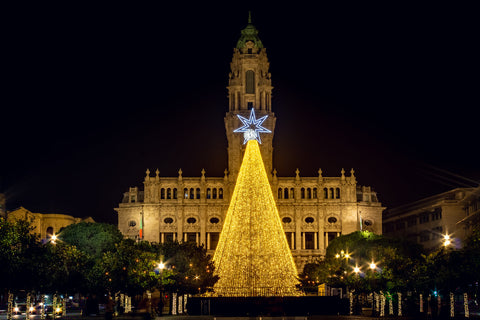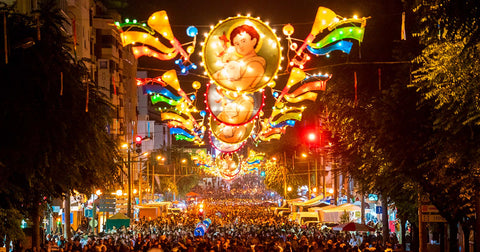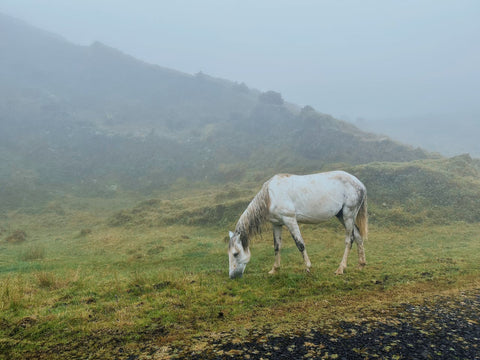In Portugal, Christmas traditions are deeply shaped by the rural life of yesteryear and by the Christian religion. Although each region has its own particularities, certain customs unite the Portuguese around this special time of year that celebrates family, faith and local traditions. In this article, we invite you to discover and share the warmth and authenticity of a country where the magic of Christmas flourishes in every village and home.
The night of the “Consoada”
The eve of December 24, called "Consoada" , is the highlight of Christmas festivities. The "Consoada" refers to a small meal that is eaten at the end of a day of fasting and whose name derives from the Latin "consolare" which means "to comfort". This traditional dinner, usually shared with family, symbolizes unity and sharing; the table is carefully set, and filled with different dishes and sweets.
Traditionally, the Portuguese eat “bacalhau” (salted cod) - or other fish dishes following the ancient idea of abstinence - served with potatoes, eggs, vegetables and cabbage cooked in water and generously drizzled with Portuguese olive oil. In recent years, however, changes have been observed in the Christmas menu; meat dishes, which were once reserved for the next day, are also beginning to be part of the menu. In the Algarve, you can taste "galo de cabidela" (cock with blood sauce) or boiled octopus (a typical dish of Beira Litoral, Trás-os-Montes and the Alto Douro).

In the north of Portugal, as in the region of Trás-os-Montes, it is customary at the Consoada table to keep the place of recently deceased family members or to leave the table set and the fire lit in the fireplace during the night so that the souls of the deceased can be spiritually nourished and warmed. This tradition shows respect for ancestors and is a way of remembering deceased loved ones during this festive period.
Traditional desserts
Christmas in Portugal would not be complete without an abundance of desserts and sweets. Each region has its specialties, but some classics are found on almost every Portuguese table:
- Rabanadas: the Portuguese equivalent of French toast, soaked in milk and egg, then fried and generously sprinkled with sugar and cinnamon.

- Filhós: delicious doughnuts made from yeast dough, often flavoured with orange or orange blossom water.
- Azevias: a half-moon-shaped fried dough filled with a cream based on chickpeas, sugar and eggs, traditional from the Alentejo.

- Bolo Rei : the “king's cake” is a crown-shaped brioche filled and decorated with candied fruits and dried fruits. In Minho, the “Bolo Rei Escangalhado” is a more rustic version, without candied fruits, but with a softer texture.

In the Algarve, desserts include Moorish influences, such as queijinhos de amêndoa (small cakes made with almonds and sugar).
The Madeiro: the great Christmas fire
In the north and centre of Portugal, it is traditional to collect pieces of wood in the days leading up to the festivities. On Christmas Eve, all the material is collected to light the "Madeiro", usually installed in a central location or on the church square.

Locals take advantage of this opportunity to gather around the Madeiro to warm up and share a convivial time before Midnight Mass, enjoying hot drinks or wine. The big fire also represents community cohesion and a tribute to Christian beliefs, as it “illuminates the birth of Jesus Christ.”
The Galo Mass
After dinner, the Christian custom is to attend the Galo (Rooster) Mass celebrated at midnight on December 24, the time of "in galli cantu" (the cock's crow), and which was the first of three masses that were part of the Christmas Day liturgy. This mass is a sacred moment for many Portuguese families symbolizing the birth of Christ and marks the end of the "Consoada". In the Alentejo, the Galo Mass is sometimes followed by performances of local "cante alentejano" (polyphonic songs).
Christmas cribs
Nativity scenes, or "presépios," occupy a central place in festive decorations. They range from simple sets of figurines to elaborate works of art that tell the entire story of the Nativity.

In some regions, such as Alentejo, nativity scenes are often life-size and set up in public spaces, with meticulous detailing often depicting elements of Portuguese rural life. In some localities, nativity scene competitions are held, showcasing the creativity and craftsmanship of the locals.
The exchange of gifts
Gifts are exchanged after midnight or on the morning of December 25, depending on the habits of each family. In the past, before Santa Claus had his place in the Portuguese Christmas by leaving the gifts under the tree, it was the Christ Child who gave them. At bedtime, children left their shoes in front of the fireplace and in the morning, when they woke up, they discovered what surprise he had left for them. If they had behaved well during the year, of course...





Comments (0)
There are no comments for this article. Be the first one to leave a message!